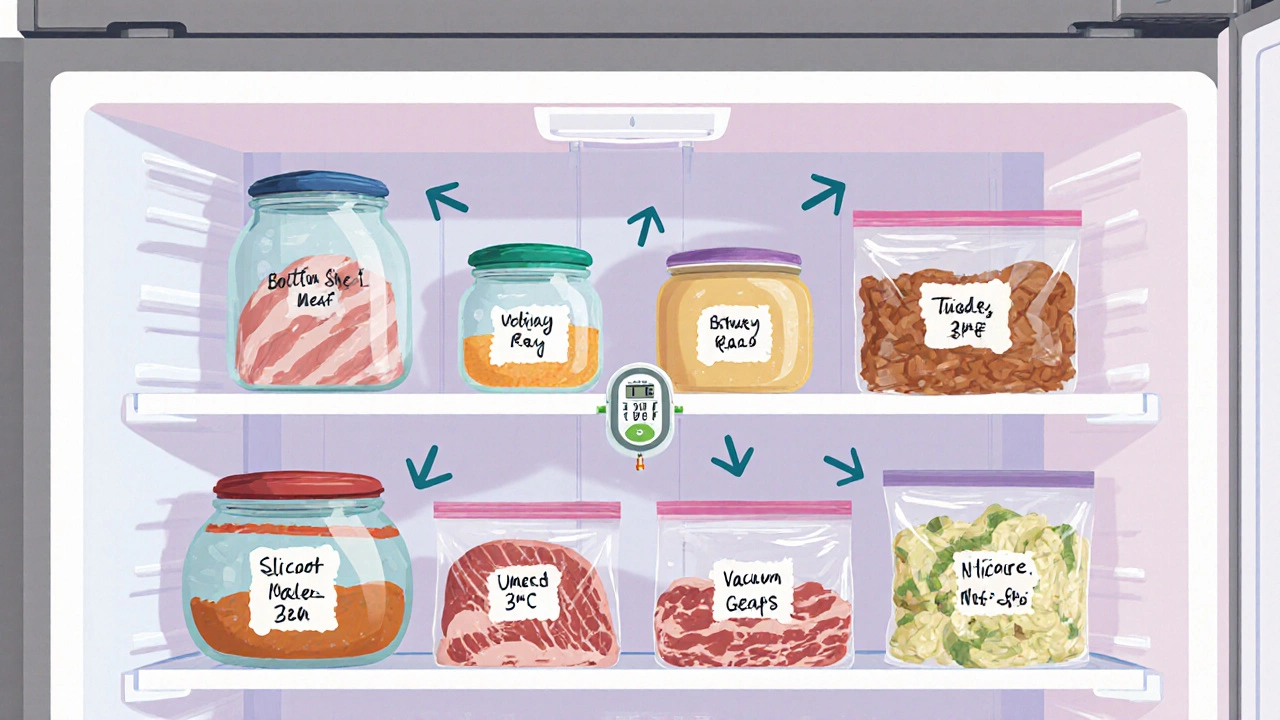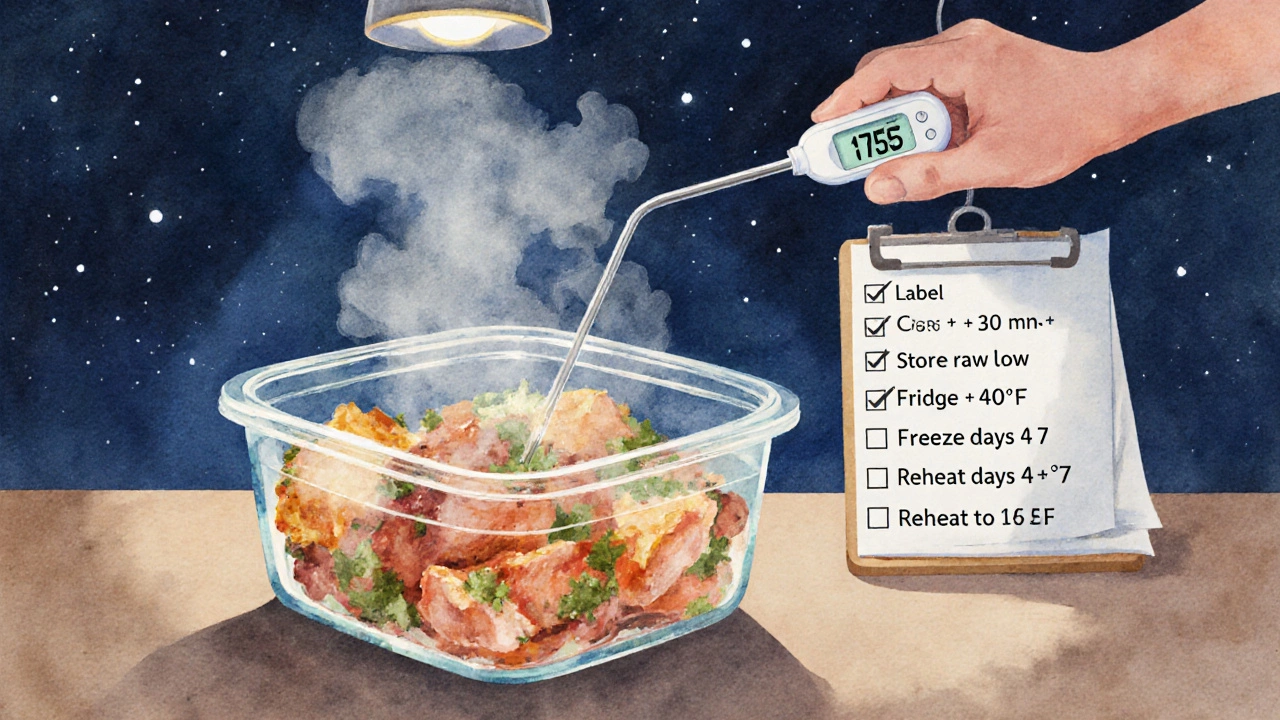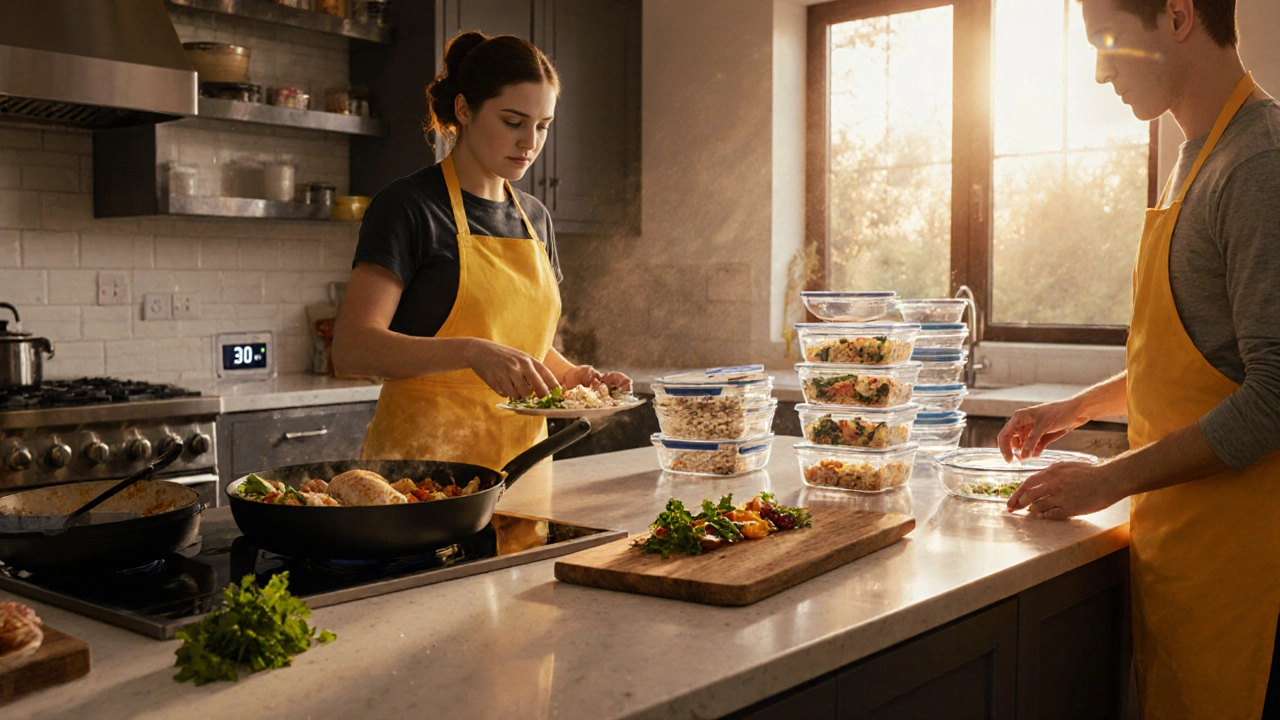7-Day Meal Prep Safety Calculator
Calculate Safe Storage Duration
Enter your meal prep details to see when your food is no longer safe to eat and how to stay within safe limits.
When you hear 7‑Day Meal Prep is a weekly batch‑cooking system where you prepare all your meals for an entire week in one go, you probably wonder if it’s safe to keep food that long. The short answer? Yes, it can be safe-if you follow the right storage rules, temperature controls, and hygiene habits. Below we break down the science behind 7 day meal prep safety, show you how to store food so it stays fresh, and give a quick checklist to avoid common pitfalls.
Why Food Safety Matters for Weekly Meal Prep
Meal prepping saves time and money, but it also creates a perfect environment for bacteria if you don’t respect a few basic rules. Bacterial growth spikes between 40°F (4°C) and 140°F (60°C), the so‑called "danger zone". When food sits in this range for more than two hours, pathogens such as Salmonella or E. coli can multiply to dangerous levels.
Understanding Food Safety Basics
Two concepts are the backbone of safe meal prep:
- Temperature control: keeping cold foods at ≤40°F (4°C) and hot foods ≥140°F (60°C).
- Shelf life: knowing how long a particular food stays safe in the fridge or freezer.
These guidelines come from the USDA Food Safety Guidelines and are widely accepted by food‑service professionals following HACCP (Hazard Analysis Critical Control Points) standards.
Ideal Storage Practices for a 7‑Day Plan
Start with clean containers. Choose BPA‑free, airtight options made of glass or high‑quality plastic. They prevent moisture loss, reduce oxidation, and stop odors from migrating between meals.
- Cool before you store: let cooked food sit at room temperature for no more than 30 minutes, then refrigerate or freeze immediately.
- Label every container: include the date cooked and a quick‑look “use by” reminder.
- Separate raw and ready‑to‑eat: keep raw meats on the bottom shelf to avoid cross‑contamination.
When possible, portion meals into single‑serve containers. This limits the number of times you open a container, preserving temperature and reducing exposure to air.
Temperature & Time Guidelines
Here’s a quick reference for common food groups:
| Food Type | Refrigerator (≤40°F) | Freezer (≤0°F) |
|---|---|---|
| Cooked poultry | 3‑4 days | 2‑6 months |
| Cooked beef / pork | 3‑4 days | 2‑12 months |
| Steamed vegetables | 4‑5 days | 10‑12 months |
| Grains (rice, quinoa) | 4‑6 days | 6‑12 months |
| Legumes (beans, lentils) | 5‑7 days | 12‑24 months |
If you’re planning a 7‑day cycle, treat the fridge as a short‑term hub (3‑4 days) and shift the later‑week meals into the freezer. Thaw them safely in the fridge overnight before reheating.

Best Containers & Tools for Longevity
Invest in a few key items that make safe storage easier:
- Glass storage jars: they don’t stain, are microwave‑safe, and seal tightly.
- Silicone freezer bags: flexible, reusable, and reduce freezer burn.
- Digital refrigerator thermometer: ensures your fridge stays at or below 40°F (4°C).
- Food‑grade zip‑lock bags with a “vacuum‑seal” function: removes excess air, extending shelf life.
Meal‑Prep Planning Tips to Reduce Risk
- Batch cook similar proteins together: reduces the number of containers you need and simplifies reheating.
- Use a ‘first‑in, first‑out’ system: place newer meals at the back of the fridge so older ones get eaten first.
- Keep a temperature log: jot down the fridge temperature each morning; if it spikes above 45°F (7°C) investigate the cause.
- Schedule a freezer‑to‑fridge transfer: move meals intended for days 5‑7 into the fridge about 24 hours before you plan to eat them.
- Don’t overload the fridge: air must circulate. A packed fridge can’t maintain safe temperatures.
Common Mistakes & How to Avoid Them
Even seasoned preppers slip up. Spot the red flags and correct them fast:
| Issue | Why It’s Dangerous | Fix |
|---|---|---|
| Leaving cooked food out for >2 hrs | Enters the danger zone, bacteria multiply | Cool quickly, then refrigerate |
| Using thin‑walled plastic containers | Allows air and moisture, speeds spoilage | Switch to glass or BPA‑free thick‑wall containers |
| Re‑heating only part of a meal | Cold spots can harbor pathogens | Stir and heat to at least 165°F (74°C) throughout |
| Storing raw meat above ready‑to‑eat foods | Drips cause cross‑contamination | Place raw items on the lowest shelf |

How to Test If a Prepped Meal Is Still Safe
Before you dig in, run a quick sensory check:
- Smell: any sour, rancid, or off odors mean toss it.
- Texture: slimy veggies or mushy proteins indicate spoilage.
- Color: dull, grayish tones are warning signs.
- Temperature: use a food thermometer; reheated meals should reach 165°F (74°C).
If anything seems off, discard it. It’s better to waste a meal than risk food‑borne illness.
Freezer vs. Fridge: When to Choose Each
For a 7‑day plan, follow this rule of thumb:
- Days 1‑3: Store in the refrigerator for quick access.
- Days 4‑7: Freeze on night 3, then move to the fridge the night before you’ll eat.
This approach respects the fridge’s 3‑4‑day safe window while still giving you fresh‑tasting meals later in the week.
Quick 7‑Day Meal‑Prep Safety Checklist
- Cool food < 30 min before refrigerating.
- Use airtight, BPA‑free containers.
- Label with cooking date.
- Store raw meats on the bottom shelf.
- Keep fridge at ≤40°F (4°C); freezer at ≤0°F (‑18°C).
- Freeze meals for days 4‑7; thaw in fridge.
- Reheat to 165°F (74°C) and check for off smells.
Follow these steps, and you’ll enjoy convenient, nutritious meals all week without compromising safety.
Frequently Asked Questions
Can I keep cooked chicken in the fridge for 7 days?
No. Cooked chicken safely lasts 3‑4 days in the fridge. For a 7‑day plan, freeze it after day 3 and thaw in the fridge before you need it.
Do I need to re‑cook meals that have been frozen?
No. Freezing stops bacterial growth. Once thawed, simply reheat to 165°F (74°C). Make sure the food is hot throughout.
Is it okay to use the same container for multiple meals?
It’s fine as long as you clean the container thoroughly between uses. Better yet, use individual portions to avoid repeated opening of a large batch.
What temperature should my fridge be set at?
Aim for 37°F (3°C) to 40°F (4°C). Use a digital thermometer for accuracy; the door shelf can be slightly warmer, so keep raw meats on the lower shelves.
Can I trust “best‑before” dates on packaged foods when meal‑prepping?
Best‑before dates refer to quality, not safety. If a product looks, smells, and tastes normal and has been stored properly, it’s usually safe past that date.





